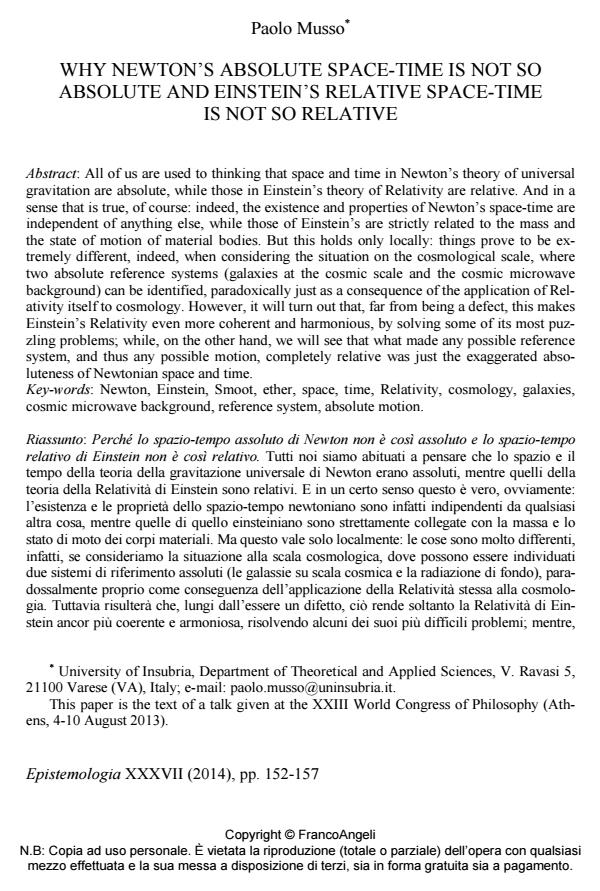Why newton’s absolute space-time is not so absolute and Einstein’s relative space-time is not so relative
Journal title EPISTEMOLOGIA
Author/s Paolo Musso
Publishing Year 2014 Issue 2014/1
Language English Pages 6 P. 152-157 File size 566 KB
DOI 10.3280/EPIS2014-001010
DOI is like a bar code for intellectual property: to have more infomation
click here
Below, you can see the article first page
If you want to buy this article in PDF format, you can do it, following the instructions to buy download credits

FrancoAngeli is member of Publishers International Linking Association, Inc (PILA), a not-for-profit association which run the CrossRef service enabling links to and from online scholarly content.
All of us are used to thinking that space and time in Newton’s theory of universal gravitation are absolute, while those in Einstein’s theory of Relativity are relative. And in a sense that is true, of course: indeed, the existence and properties of Newton’s space-time are independent of anything else, while those of Einstein’s are strictly related to the mass and the state of motion of material bodies. But this holds only locally: things prove to be extremely different, indeed, when considering the situation on the cosmological scale, where two absolute reference systems (galaxies at the cosmic scale and the cosmic microwave background) can be identified, paradoxically just as a consequence of the application of Relativity itself to cosmology. However, it will turn out that, far from being a defect, this makes Einstein’s Relativity even more coherent and harmonious, by solving some of its most puzzling problems; while, on the other hand, we will see that what made any possible reference system, and thus any possible motion, completely relative was just the exaggerated absoluteness of Newtonian space and time.
Keywords: Newton, Einstein, Smoot, ether, space, time, Relativity, cosmology, galaxies, cosmic microwave background, reference system, absolute motion.
- De Bernardis P. (2010). Osservare l’universo, Bologna, il Mulino.
- De Felice F. (2000). Gli incerti confini del cosmo, Milano, Mondadori.
- Einstein A. (1920). Äther und Relativitätstheorie: Rede gehalten am 5 Mai 1920 an der Reichs-Universität zu Leiden. In Bellone E. (ed.) (1988), Albert Einstein – Opere scelte,
- Torino, Bollati Boringhieri, pp. 507-516.
- Greene B. (2004). The fabric of cosmos: space, time and the texture of reality, New York, Random House (trad. it. La trama del cosmo. Spazio, tempo, realtà, Torino, Einaudi, 2006).
- Musso P. (2011). La scienza e l’idea di ragione, Milano/Udine, Mimesis.
- Pais A. (1982). ʻSubtle is the Lord…’ – The science and the life of Albert Einstein, Oxford, Oxford University Press (trad. it. Einstein – “Sottile è il Signore...” – La scienza e la vita di Albert Einstein, Milano, Mondadori, 2006).
- Smoot G. (1993). Wrinkles in time, New York, William Morrow & Co. (trad. it. Nelle pieghe del tempo, Milano, Mondadori, 1994).
- La cosmologia nel pensiero di Evandro Agazzi Paolo Musso, in EPISTEMOLOGIA 2/2015 pp.247
DOI: 10.3280/EPIS2015-002006 - Holismo local y cambio semántico en la teoría de Kuhn Daniel Labrador-Montero, in Revista Colombiana de Filosofía de la Ciencia /2024
DOI: 10.18270/rcfc.4409
Paolo Musso, Why newton’s absolute space-time is not so absolute and Einstein’s relative space-time is not so relative in "EPISTEMOLOGIA" 1/2014, pp 152-157, DOI: 10.3280/EPIS2014-001010